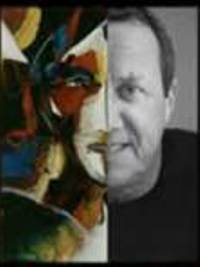 |

|
 |
There is an underlying unity in the universe, Jean-Claude Gaugy believes. The constant quality that weaves its way through everything is movement - rhythmic life, repeating itself in infinite forms.
In Gaugy's acclaimed carved paintings, all ancient and archetypal expressions of the human soul find articulation in textured line and luminous color, and in images that reflect the essence of who we are.
The call to create resounds from deep in Gaugy's ancestral past. For almost 400 years his family worked as artisans in the Jura mountain region of France, quietly maintaining the dignity, independence, and strength of those who understand the demands of fusing function and beauty.
For his part, Gaugy continues a tradition of synthesis, fusing well-mastered skills of sculpture and painting in a signature style that has become known as Linear Expressionism. He carves rhythmic, flowing, yet decisive line into wood, and then complements that powerful sense of movement with the rich complexities of color.
The results are internationally admired and collected works that speak to the wholeness of being human.
Born in 1944, young Gaugy heard his own call of independence and left his mountain village for Paris at age 14. There he survived by doing sketches in cafes and soon was invited by the owner of a lavish dining club to paint portraits of customers. During the day Gaugy pursued classical art studies and the Ecole des Beaux Arts, focusing on his great love of sculpture.
One night, renowned surrealist Salvador Dali entered the dining club and asked to see more of Gaugy's art. Dali was so taken with what he saw that he arranged for a one-man exhibition of Gaugy's paintings at the Galerie de Seine in Paris. Soon Gaugy's work was being shown in Brussels and Germany. The Soviet government purchased three of his large paintings at a group show at the Museum of Modern Art in Paris, and the young artist was flown by consular jet to Moscow for museum installation of the works.
With a insatiable thirst for knowledge, Gaugy studied during the following years at a number of prestigious art schools in Paris, Rome, Germany and Moscow, as well as apprenticing in England with famed sculptor Henry Moore. In 1966 he immigrated to the United States, a move that led to the development of his trademark Linear Expressionist style.
Three-dimensional sculpture did not command the interest in the United States that it did in Europe. But Gaugy was unwilling to give up his love of carving. Instead, he began creating deeply carved bas-relief wall sculptures in wood. Gradually the carving became less deep and more linear, and color was integrated into the work.
As his art evolved and matured, Gaugy found himself commissioned to create many murals, some as large as 50 feet. Among is clients were the Rockefeller Foundation, New York's Columbia Presbyterian Medical Center, and the National Foundation for Depressive Illnesses, which in 1991 unveiled Gaugy's 30-foot work at the National Building Museum in Washington D.C. In 1994, a major exhibition of Gaugy's carved paintings was sponsored by the government of Luxembourg.
With international recognition and a lifetime of accolades, Jean-Claude Gaugy continues to rise at 4:30 each morning with a singular focus. He brings to his studio all the intensity of an artist whose abiding passion is clear communication through his art.
Just as he understands the creative source to reside in the depths of his being, so his intent is to touch that same pure place in those who experience his art.
"Everything I do, I have to become it," Gaugy has said. "There's no thought; you try to get yourself out of the way when you're painting, and watch things happen."
|
|
